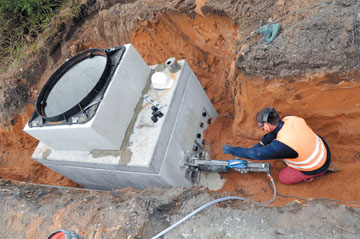Network Offers Virtually Unlimited Bandwidth
 |
A contractor from Product Manager, Defense Communications Systems–Europe, drills through a maintenance hole for fiber optic conduit and cable. |
The U.S. Army recently finished construction of an optical network that offers troops in certain foreign locations all the data transmission speed and availability they need for the foreseeable future. After Defense Communications Systems–Europe completed the development process earlier this year, the 5th Signal Command took over control of the network and is studying how best to migrate from asynchronous transfer mode legacy systems to the new one. The technology will greatly enhance capabilities for users across Europe and in
With the project construction fundamentally complete, U.S. Army Europe has the infrastructure for a Dense Wave Division Multiplexed-Optical Transport Network (DWDM-OTN) capable of scaling to 400 gigabits per second of bandwidth. By comparison, the network currently in use generally provides 10 gigabits per second to a building. “DWDM is providing essentially unlimited bandwidth,” explains Lt. Col. Joseph Dupont,
The DWDM-OTN works through a capability that takes 40 different channels of light and multiplexes (or combines) them into a single stream that is passed down single strands of fiber. Col. Dupont uses an analogy from the 5th Signal Command that likens the process to the energy beams used in the movie Ghostbusters. To finish off a powerful spirit, three ghostbusters combined their individual rays into a single stream to increase the power output. The DWDM-OTN takes different signals and transmits them simultaneously at varying wavelengths along a single fiber. The action enables a fiber to increase capacity.
The hardware and middleware enable the scaling bandwidth capability of the network. The DWDM-OTN has three rings located in
Part of GNEC is the idea of everything over Internet protocol (EOIP). To provide a global network to the Army as a whole, the military branch needs one network capable of delivering all the services. “What we’ve done is provided that piece of it for the Army in
The DWDM-OTN is the largest DWDM network in the military. The three rings of fiber traverse nearly 1,305 miles and include 15 nodes throughout
The DWDM-OTN encompasses the nonsecure Internet protocol router network and the secret Internet protocol router network. Circuits have been dedicated to the 66th Military Intelligence Group and the U.S. Africa Command Headquarters. In addition, the network offers greater capability to forward-deployed warfighters who reach back into the European network. Though those troops still will be limited by the bandwidth available in their immediate area, the information will reach those networks much more quickly through the DWDM-OTN.
The network includes several features to enhance reliability and survivability including out-of-band management tools. Out of band means the tools use a network separate from the primary network, so the tools are residing completely independently of the DWDM-OTN. If a problem occurs—even a cut link—personnel can resolve the issue because they no longer need to reach into the problem area to fix it. As long as one of the 15 nodes on the network can open up a management application, network personnel can access the other 14 nodes, determine the problem and heal the system. This ability offers the network more security than that of legacy networks.
Developers experienced the resiliency of the network during an initial test when a physical fiber was cut, and the damage went unknown to the testers because the network automatically rerouted the signal. They learned about the damage only through telephone calls and reports. Col. Dupont explains that by reviewing the logs, the testers were able to see how the cut happened and how the data automatically rerouted. “That’s definitely a neat feature of this network,” the colonel says.
Col. Dupont’s office finished its development and testing earlier this year and passed control of the network to 5th Signal Command, which has responsibility for operations and maintenance. All the requirements for initial operating capacity have been met, and 5th Signal is working on the operational assessment to plan the migration of the legacy technology to the DWDM-OTN network.
 |
Joe Varga, project lead on the Dense Wave Division Multiplexed-Optical Transport Network (DWDM-OTM), readies a cabinet for DWDM hardware. |
The Army contracted LGS Innovations in February 2006 to help create the DWDM-OTN, and the contract on the project extends until February 2011. The company has three employees working with 5th Signal on tasks such as implementing information assurance necessities and developing maintenance procedures. In addition, if the Army moves forward with building the additional two rings for the network, LGS personnel could step in to continue development work.
Army
However, because the bandwidth will be in place from the start, users will never experience troubles such as service degradation. Such issues would have had to be resolved after the fact if not for these front-end upgrades. John Ritchey, an optical systems engineer for LGS, says individual warfighters will experience a more effective data services network, whether they notice it in their day-to-day use or not. Ultimately, he states, the quality, service, bandwidth and resiliency of the network will give 5th Signal the ability to manage the network and make sure critical data arrives on time.
LGS’ role in the original network development was to put in place the optical equipment that performs the optical transport and to interconnect that with the existing fiber. Then, company employees incorporated multiprotocol layer switching, integrated systems and performed tests at that level. LGS employee John Mills, the chief architect on the project, says 5th Signal officials had conceptual ideas of what they wanted, and they did not want LGS to implement the ultimate logical design. The company tested functionality, implementing a generic logical design on which they ran exhaustive tests during implementation of the third ring.
Mills says some people have wondered why it took so many years to develop the network, explaining that work had to be done in phases. One section of fiber was unavailable during development, so personnel had to deploy rings two and three as a single large ring and then divided them during the final deployment phase. LGS still was doing fiber augmentation as of August. “We expect there may be additional nodes added to those rings,” Mills explains.
Ritchey says that the technology deployed on the DWDM-OTN is the same as that in the core of commercial networks, though such capabilities are new to the Defense Department. The military personnel responsible for services also have more control managing the DWDM-OTN than they did over legacy networks. “They can define services that are critical and set quality-of-service requirements so that the network guarantees that critical service gets through,” he shares.
LGS developers highlighted this process while showing the capabilities to a military leader. Bill Womack, the LGS program director on the project, says that during the demonstration, personnel had streaming video come across one ring that they also hit with heavy data traffic. The network was able to reroute circuits dynamically to show the video in good quality based on requirements set by the user. The network can do this in the event of traffic congestion or component failure.
According to Mills, the DWDM-OTN is more autonomous and dynamic than other networks. Switches talk to each other, and the network is intelligent enough to set up another circuit with the same quality of service as a different one when necessary. The network has survivability at multiple levels with rerouting done in milliseconds.
Though Col. Dupont says the DWDM-OTN network sets a high standard, he does not know if others can or would emulate it. The 5th Signal Command owns the fiber optic network in Europe unlike in the continental
WEB RESOURCES
5th Signal Command: www.5sigcmd.army.mil
2009 Army Posture Statement GNEC: www.army.mil/aps/09/information_papers/global_network_enterprise_construct.html
LGS: www.lgsinnovations.com




Comments